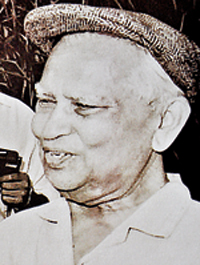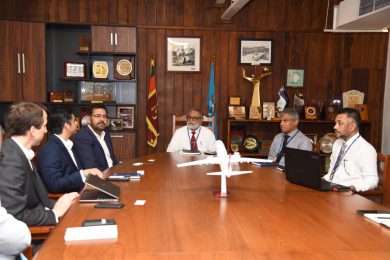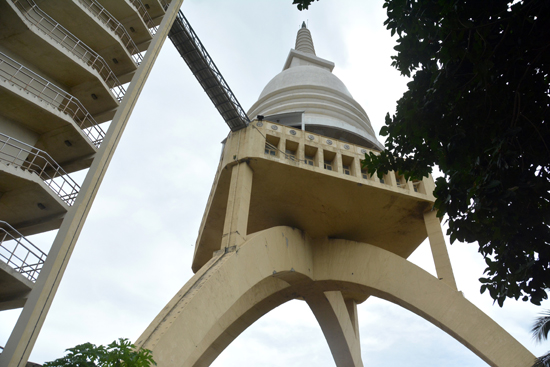When the idea for this stupa- the Sri Sambodhi- was mooted, there were several stipulations.
by Yomal Senerath-Yapa
One of Colombo’s least visited landmarks the Sri Sambodhi Viharaya in Fort, stands as a memorial to its creator, the great modern engineer Dr. A. N. S. Kulasinghe whose birth centenary fell on October 26
Time was when the sailor, longing for a glimpse of Ceylon’s shoreline, would holler a relieved ‘Land Ahoy’ as soon as he glimpsed a shadow of a mountain – rising far away in the central uplands- a holy beacon venerated by all religions- Adam’s Peak.
Today, the metropolitan skyline (and all its vapours) have mostly blocked out that solitary peak afloat in mist. The Buddhist beacon that has taken its place- flashing right near the Colombo harbour for the land-bound-is a white bell of a stupa, hoisted skywards on light yellow arches- the central landmark of Colombo from a crow’s eye view.
This sacred symbol, propelled skywards on futuristic reinforced concrete curves, is the city’s memorial to its creator and great modern engineer Dr. A. N. S. Kulasinghe- whose birth centenary fell on October 26 this year.
He is best remembered for inventing reinforced concrete- but was also a pioneer in areas such as ferro-cement boat building, applications of the Shell design theory in the construction and alternate low cost construction material.
He gifted to Colombo its Planetarium, and to the island in general the massive Kotmale Seya- the upcountry stupa that rises amidst green hillscapes- the Polgolla Bund and the State Engineering Corporation head office. The rather functional modern elegance he conjured out of simple geometrical patterns marks him for an artist- with a minimalist poetry that blends enviably well with the environs.
When the idea for this stupa- the Sri Sambodhi- was mooted, there were several stipulations.
Whatever Buddhist monument to adorn the metropolis, should not clash with a city ethos which, while it did not have an exactly ‘uniform’ elegance- in this quarter was still ruled by a neat British colonial aura- with graceful buildings hemmed by palms. Besides, new tones were being set. This was the ‘last age’ of art deco- while Minnette de Silva’s square tropical bungalows were spilling out in Cinnamon Gardens.
The new symbol would have to blend with the Fort’s maritime utilitarianism and the harbour- but it should, at the same time, exude that ancient aura of a spiritual sanctum- with the serene village vihara architecture replicated in all its calmness.
To ensure this, the stupa is simple without. Within, however, it manages to capture spiritual awe and the whole ethos of Sri Lankan Buddhism.
The idea was mooted by the Ven. Henpitagedara Gnanaseeha Thera in 1953- in order to stamp the city with a Buddhist symbol- in a confused melting pot of denominations of Christianity, vibrant Hinduism and Islam.
The plan took off in 1956 or the Buddha Jayanti year, when the world commemorated the 2500th anniversary of the passing away of Buddha (in 543 BC).
Today, this modern hybrid stupa is hidden right in the limelight- hardly visited despite its vertiginous marvel- offering splendid city and harbour views from the sacred seclusion that is nearly a 110 feet high.
The stupa measures 154 feet while the entire structure is 261 feet.
A stair tower ascends parallel to the arches. It has a lift too but the 258 steps are an adventure- as the land and sea undulate as you climb- the skyscrapers, the great “Galle Buck” lighthouse and magnificent vistas of a bustling harbour and ocean.
The elegant gantara (bell) stupa is poised on a yellow slab upon the arches. This slab, wider than the stupa’s base, is divided into four rooms- cocoons for weary city dwellers to meditate.
Once you penetrate into the heart of the stupa, the silence of the great dome reverberates.

Sculpted panels and murals rise halfway up to the dome. There is something hypnotizing about the way the murals adorn the dome. The 31 murals above the classic arched windows depict the artist’s take on the Buddhist world’s chronicle- beginning from the birth of Prince Siddhartha to the 2500th Jayanti year.
The murals were done in the mid-1980s by the Ven. Mapalagama Vipulasara Thera and are a pictorial record of the Buddhist world from Lumbini to Colombo. Everything- including the enlightenment and the jungle clad ruins of Anuradhapura and Polonnaruwa- is depicted in serene watercolours. Standing in the very centre you get the curious sensation of being at the centre of the Buddhist world. The stupa was traditionally the symbol of the universe- and being within this echoing dome telegraphs a mystic message through the ages as to why this was so.
High in the cathedral-like, albeit much simpler curving dome, are four bronze guardian deities on blue lotus plinths- their hands clasped in worship. These are the satara varam gods- Viruta, Virupashta, Vaishravana and Dutharashta- each lord of one cardinal direction and together the caretakers of Buddhism.
Managed by the Sri Lanka Ports Authority, the Sri Sambodhi stupa stands next to the Sri Lanka Ports Authority Maritime Museum down Chaitya Road, Colombo 1. The premises are open from early morning till 6 in the evening.
| An engineer who became a household name |
Of Dr. A.N.S. Kulasinghe’s significant contribution to this country, Senior Professor in Civil Engineering at the University of Moratuwa, Prof. Priyan Dias, in an appreciation published in the newspapers about his mentor and colleague, following his demise in February 2006 wrote:“He is a household name in our country – a feat rarely achieved by engineers, whose indispensable contributions to society are almost always shrouded in anonymity. He demonstrated pioneering leadership and remarkable ingenuity in many fields of engineering, displaying a virtuosity that is hardly ever seen in these days of ultra specialisation.”Nonetheless “he must have been heartbroken when Sri Lanka turned towards foreign technology for prestressed concrete railway sleepers in the nineties, a technology he had home-grown in the seventies. In spite of this, he trod the often lonely path of innovation and self-reliance.”“That in fact is the very appropriate title of the Kulasinghe Felicitation Volume produced by the Institution of Engineers, Sri Lanka: “Innovation and Self-Reliance”. The era of engineering in Sri Lanka covered by the volume is also called the “Heroic Age”. Innovation then was the other driving force in his career. T.Y. Lin’s well known text on prestressed concrete is dedicated “To engineers who, rather than blindly following the codes of practice, seek to apply the laws of nature”. … Lin could (very well) have had the young Kulasinghe in mind…” |
Courtesy: The Sunday Times, November 2, 2019























